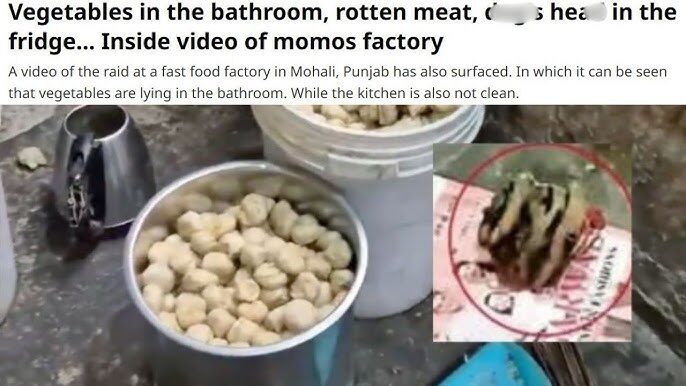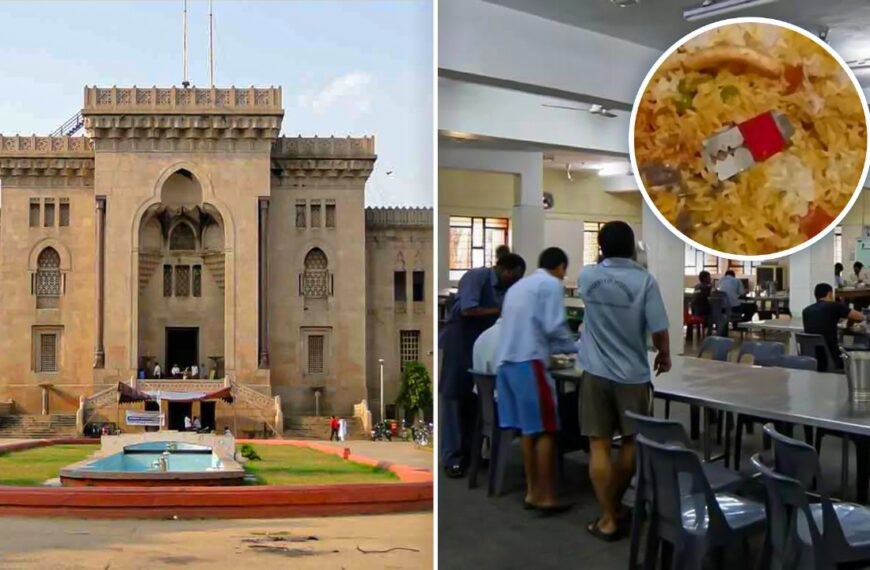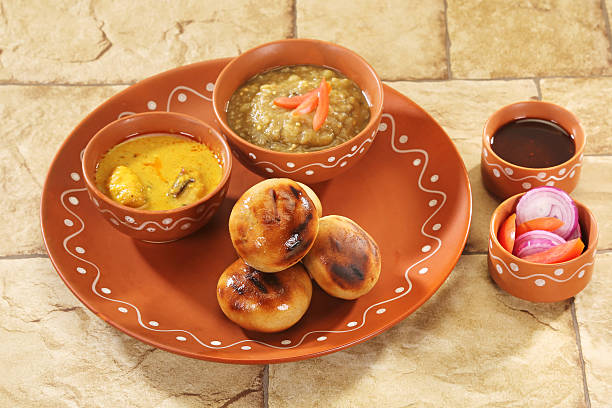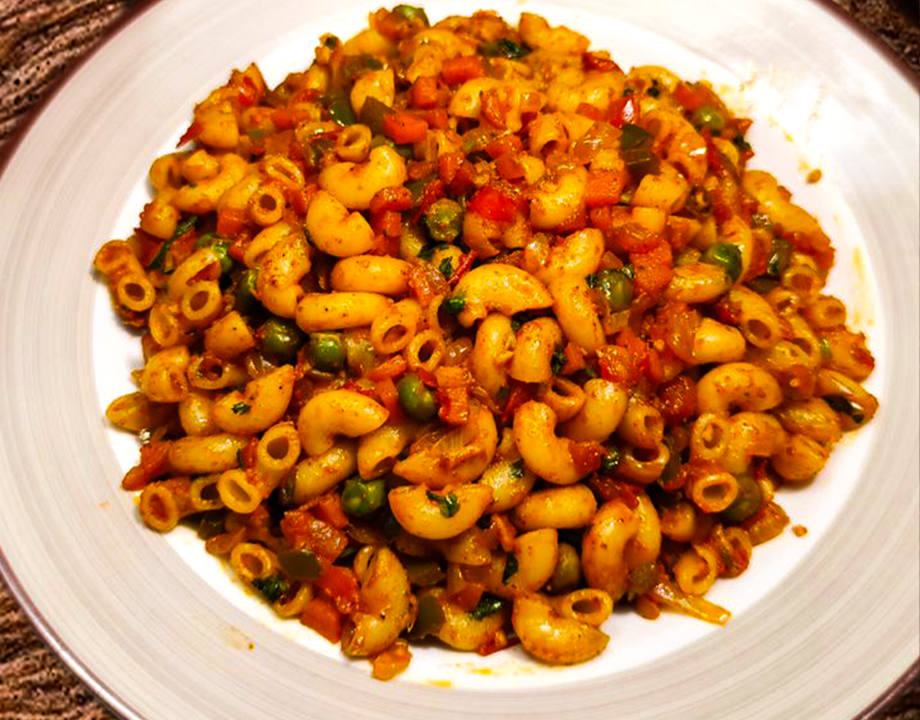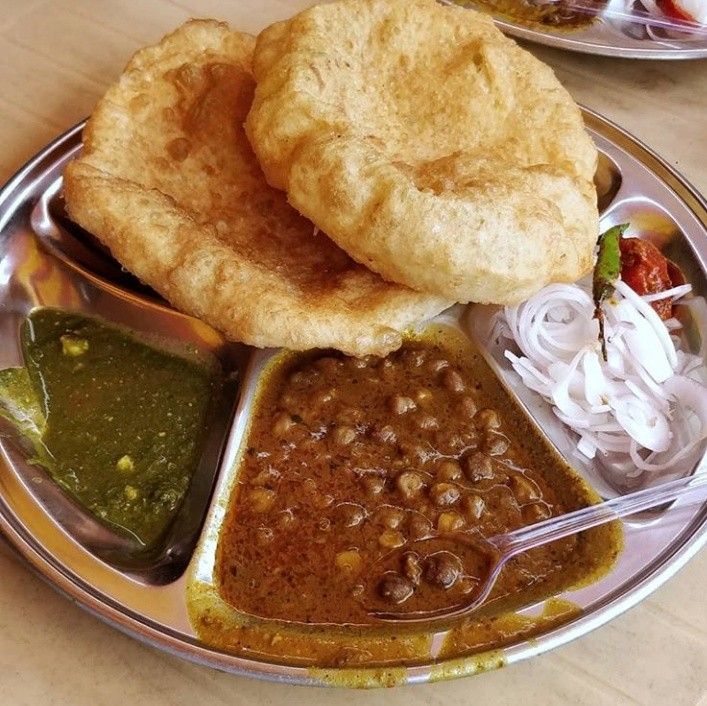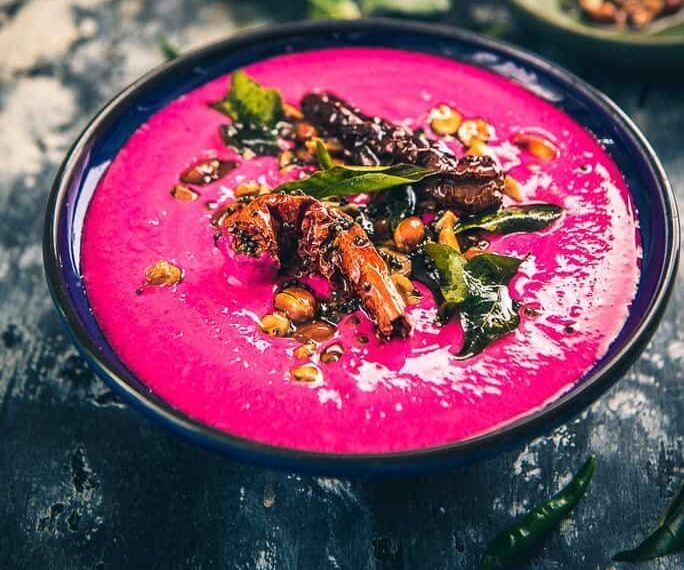In This Article
In the vibrant heart of Mumbai—a city often glorified as a melting pot of cultures, cuisines, and communities—a simmering pot boiled over in April 2025. The Sambhav Darshan Co-operative Housing Society in Ghatkopar, usually just another quiet neighborhood amidst the city’s never-ending bustle, unexpectedly became the epicenter of a cultural wildfire. The issue? Non-vegetarian food. But dig deeper, and this wasn’t just about what was being cooked in someone’s kitchen.
It exposed the deep-seated fractures in Mumbai’s social landscape, igniting a sensitive clash between Marathi and Gujarati communities. What began as a neighborly spat soon evolved into a full-blown political and cultural debate—one that forced the city to once again reflect on its identity, inclusivity, and the boundaries of tolerance.
At first glance, the issue seemed like something that could be easily dismissed as a minor neighborly disagreement. But the gravity of the situation became clear as it rapidly escalated into a controversy that reverberated throughout the city’s complex social fabric. The debate had deep implications—far beyond food choices. It touched upon questions of identity, cultural pride, and the struggles of living in a multi-ethnic urban environment. The cultural dynamics between Marathi and Gujarati communities had been at the core of Mumbai’s political discourse for decades, and this controversy highlighted just how easily such tensions could flare up in the most mundane of circumstances.
Personal Disagreement or Cultural Attack? The Marathi vs Gujarati Non veg Clash Unfolds
It all began with what many might dismiss as a personal disagreement between neighbors. But for Ram Ringe, a proud Marathi resident of Sambhav Darshan, it was far more than that. According to his statement, a Gujarati neighbor confronted him with a shockingly derogatory remark: “You Marathi people are dirty, you eat fish and meat.” The statement, offensive on multiple levels, wasn’t just an insult to his food preferences—it felt like an attack on his roots, his identity, and his dignity.
In a city where eating fish curry is as traditional as celebrating Ganesh Chaturthi, Ringe felt humiliated. For him, this wasn’t about a meal—it was about respect. It wasn’t the first time he had experienced such remarks, but it was the first time it was so openly uttered in a way that felt calculated and aggressive. Unable to digest the insult, Ringe turned to the Maharashtra Navnirman Sena (MNS), a political party known for fiercely championing Marathi rights. The move was strategic—he didn’t just want an apology; he wanted acknowledgment of the deeper discrimination at play.
It is important to note that in a city like Mumbai, food choices are more than just a matter of personal taste. They are often linked to one’s cultural heritage and social standing. For many Marathi families, fish, mutton, and other non-vegetarian dishes are deeply ingrained in their way of life. To be shamed for their dietary preferences was not just an affront to their individual freedom, but to their cultural identity as well.
This wasn’t an isolated instance of food-based bias. Many non-vegetarian families in Mumbai have long felt the subtle, and at times blatant, pressures from vegetarian-majority societies that restrict or shame meat consumption. But this time, the issue exploded—because the insult wasn’t whispered, it was shouted. This felt like a direct attack on the very cultural fabric of their community, and it sparked a movement.
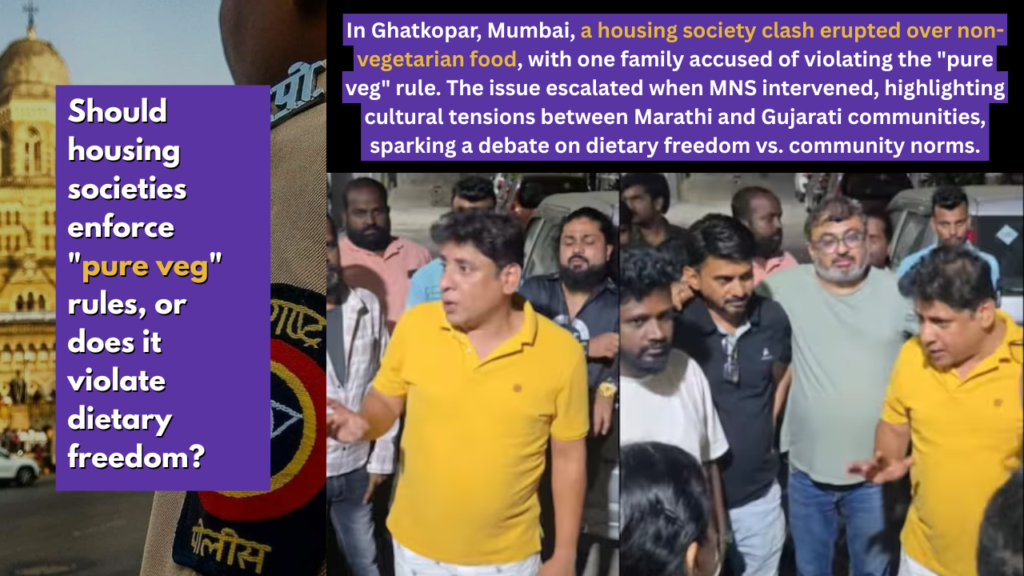
Non-Veg Food Disputes: Cultural Tensions in Urban Housing Societies
Mumbai, often celebrated as India’s most diverse metropolis, has always been a city of contrasts. Beneath its cosmopolitan veneer lies a complex web of cultural dynamics, where harmony and tension exist in equal measure. Recent incidents continue to underscore the brewing discomfort within the city’s fabric. In May 2024, workers from Shiv Sena (UBT) alleged they were denied entry into a housing society in Ghatkopar due to their Marathi identity. This event, though seemingly isolated, reflects a larger and more persistent undercurrent of silent division.
Housing societies, often envisioned as microcosms of the city’s unity, have inadvertently become spaces where cultural and communal boundaries are drawn. Behind closed doors and iron gates, these societies erect invisible barriers—not defined by geography but by language, food, and community background. Kitchens exude the aromas of distinct regional cuisines, balconies become extensions of individual cultural identities, and society committee meetings often echo with unspoken biases.
The incident in Ghatkopar is not an anomaly; it is part of a recurring narrative in Mumbai’s history. The city has long grappled with its internal identity crisis, shaped by waves of migration and shifting demographics. Marathi pride movements have often clashed with the entrepreneurial influence of the Gujarati community, creating a tug-of-war over the city’s cultural soul. Mumbai, a magnet for dreamers from across the country, is also a space where deep-seated prejudices quietly persist.
This dichotomy is especially visible in housing societies, which are forced arenas of coexistence. Residents of various linguistic and regional backgrounds often share walls but not worldviews. Differences over dietary preferences—such as vegetarian-only housing policies—serve as battlegrounds for cultural assertion, while linguistic divides play out in the choice of common languages during meetings.
Mumbai’s evolution as a melting pot has always hinged on its ability to balance cooperation with conflict. However, incidents like these highlight the fragility of this balance. The city, known for its resilience, must address these silent divisions to truly live up to its cosmopolitan image. Inclusivity cannot thrive behind gates that discriminate, nor can harmony emerge from societies that perpetuate cultural silos.
Ultimately, Mumbai’s strength lies in its diversity, but its future depends on how it reconciles the silent borders within. Only by acknowledging and bridging these divides can the city truly uphold its legacy as India’s most vibrant metropolis.
The Power of Food: A Symbol of Identity and Culture
Food has always been a powerful symbol of identity. In Mumbai, where multiple ethnic groups coexist in close proximity, food choices have often been tied to both personal and collective identity. Whether it’s the fish curry and rice traditionally eaten by Marathi families or the vegetarian dishes that form the cornerstone of many Gujarati homes, food is rarely just about sustenance—it is a way of life, a point of pride, and a reflection of one’s cultural heritage.
For many communities, food preferences are an emotional and cultural statement. For the Marathi community, fish and meat hold deep-rooted cultural significance, representing centuries of maritime traditions and agricultural practices. Similarly, for the Gujarati community, vegetarianism is not only a dietary choice but a part of a larger philosophical and religious ethos that permeates daily life. In such a diverse city, food becomes a battleground for cultural ownership, and every meal shared or rejected can feel like a subtle assertion of one’s place within the city’s broader social fabric.
Such tensions—Marathi vs. Gujarati, vegetarian vs. non-vegetarian—aren’t just personal biases. They’re often institutionalized. Rules about “pure-veg” buildings, bans on cooking meat, or unwritten codes on community norms subtly push minority residents to the margins. What’s troubling is how easily these rules get justified in the name of “peace” or “harmony,” while actually enforcing cultural exclusion. These unwritten norms often perpetuate a sense of “otherness,” where individuals who do not conform to the dominant culture feel like outsiders in their own homes.
The incident at Sambhav Darshan Housing Society exemplified how something as mundane as food can become a marker of division, forcing individuals to confront long-standing cultural tensions. The fact that such tensions exist under the surface of Mumbai’s supposedly inclusive environment speaks to the deep-seated issues surrounding multiculturalism in urban India.
The Protest: MNS Intervenes Amidst Rising Tensions
When Ram Ringe brought the issue to MNS, it was no longer just a resident’s complaint—it was a matter of Marathi pride. The Maharashtra Navnirman Sena, known for its fiery oratory and street-level activism, wasted no time. Within days, MNS workers showed up at the housing society, confronting the residents with slogans, speeches, and questions. The scene was charged, emotional, and captured on video, which quickly went viral across platforms.
In the viral clip, MNS leader Raj Parte is seen addressing the society in a tone that was part warning, part plea. He didn’t just accuse the Gujarati residents of being discriminatory—he accused them of forgetting Mumbai’s roots. “This city is built on the hard work of Marathi people,” he said. “We welcomed everyone, but that doesn’t mean you get to insult our traditions.”
Parte’s words resonated with many Marathi families who, for years, have felt pushed aside in neighborhoods where their cultural practices were seen as lesser. The sentiment was clear: the Marathi community had long felt sidelined, especially in areas dominated by Gujarati business elites or non-vegetarian-majority societies. The rising tide of political activism brought by MNS was seen as a response to these perceived slights, aimed at asserting Marathi culture’s place in the city.
But his aggressive tone also raised eyebrows—was this political muscle or a genuine cry for dignity? Critics of MNS feared that the party was using the situation to further deepen the divide between communities and to strengthen their political hold over the Marathi-speaking population. Some accused the party of trying to turn a personal grievance into a larger cultural and political issue.
As the video spread, so did the public discourse. Supporters hailed MNS for standing up for Marathi identity. Critics accused them of stoking communal flames. But one thing was clear—the issue was no longer just about fish or mutton. It had become a fight for space, respect, and representation.
Police Intervention: Authorities Step In to De-escalate the Situation
With emotions spiraling and the media catching wind of the story, the Mumbai Police had to act quickly. Law and order in Mumbai is a delicate balance—especially when cultural issues intersect with political activism. Senior officers arrived at the housing society, holding urgent meetings with both parties to calm the waters.
Authorities assured that a formal inquiry would be conducted into the allegations of verbal abuse and housing discrimination. The police also emphasized that under Maharashtra’s co-operative housing society rules, no resident can be discriminated against on the basis of food habits or cultural identity. This was a reminder that the law guarantees freedom of choice, including the right to eat without fear of discrimination.
Behind the scenes, the message was clear: this cannot escalate further. Mumbai has witnessed enough violence in the past over linguistic and cultural politics. The police presence was as much about peacekeeping as it was about damage control. Their efforts helped dial down the tension, but the public debate had already taken on a life of its own.
Political Reactions: Leaders Condemn Discrimination
The controversy surrounding the denial of entry to Shiv Sena (UBT) workers in a Ghatkopar housing society quickly outgrew its local roots, evolving into a citywide—and even statewide—debate. Political leaders from across the spectrum jumped into the fray, offering varying interpretations and solutions, each shaped by their ideological leanings.
Congress MLA Vijay Wadettiwar didn’t mince words in his critique. Speaking at a press conference, he asked pointedly, “Is this the Maharashtra we’re proud of? If the sons of this soil feel unwelcome in their own homes, then what are we governing for?” His remarks resonated with many, especially senior citizens and middle-class families who feel their cultural practices and traditions are increasingly marginalized in the city’s rapidly gentrifying neighborhoods. Wadettiwar’s demands included stricter legislation to prevent cultural discrimination in housing societies and a renewed focus on preserving Marathi traditions through urban planning and policymaking.
Meanwhile, leaders from the BJP struck a different tone. They cautioned against over-politicizing what they called a “neighborhood issue.” Stressing the importance of Mumbai’s inclusivity, they reminded the public that food choices and cultural practices are deeply personal and constitutionally protected. BJP spokespersons warned that turning every disagreement into a political issue risks deepening divides and fracturing the city’s fragile unity.
As the political debate unfolded, the controversy spilled into Mumbai’s social spaces, both physical and digital. WhatsApp groups buzzed with arguments, ranging from thoughtful critiques to inflammatory rhetoric. Twitter threads offered contrasting takes, with some framing the incident as a symbol of liberalism under siege and others decrying it as cultural colonization. At chai stalls and office canteens, everyday conversations mirrored the city’s broader divisions. While some dismissed the uproar as “just politics,” others recognized it as a reflection of deeper unease brewing in Mumbai’s cultural landscape.
This incident highlighted the delicate balance Mumbai continues to navigate—between preserving its unique cultural heritage and embracing its role as a progressive, inclusive metropolis. The city has always been a confluence of identities, but moments like this underline the fault lines that quietly persist. The debate may fade from headlines, but the questions it raises about belonging, inclusivity, and coexistence will remain central to Mumbai’s evolving narrative.
What Needs to Be Done?
So, what’s the way forward? How do we prevent such flare-ups in a city that thrives on diversity yet struggles with it daily?
First, housing societies must recognize that diversity is their greatest strength—not a problem to be managed but a legacy to be celebrated. Blanket bans on non-vegetarian food or the imposition of “cultural norms” that exclude certain communities are not only unconstitutional—they are un-Indian. The constitution guarantees the right to live and eat with dignity. Any society rule that violates this principle needs to be called out and corrected.
Second, there’s an urgent need for cultural sensitivity training within urban residential complexes. This could take the form of dialogue circles, awareness workshops, or even curated events where residents share their traditions, stories, and yes—meals. A fish fry or a dhokla tasting session can sometimes do what a hundred meetings cannot.
Third, political parties must act responsibly. Advocacy is welcome. Polarization is not. Using cultural pride to uplift voices is valid—but using it to divide is dangerous.
Finally, we as citizens must evolve. It’s 2025. If we can work in global teams, adopt hybrid lifestyles, and use AI in our everyday tasks, surely we can also accept that our neighbors may cook differently—and love them anyway.
Conclusion
The incident at Sambhav Darshan Co-operative Housing Society isn’t just a news story—it’s a mirror. A mirror reflecting the hidden cracks in Mumbai’s social fabric. A reminder that while skyscrapers may rise and metros may run, the soul of a city lies in how its people live together.
It’s easy to talk about unity. Harder to practice it. Especially when it shows up in uncomfortable ways—like the smell of fish curry in your vegetarian corridor or the sound of Ganpati aarti echoing in a Jain-dominated lane.
But therein lies the opportunity. To grow not despite our differences, but because of them.
Mumbai has always stood for resilience, for hustle, for heart. But now it must also stand for harmony. Not the kind that comes from sameness—but the kind that comes from respect. From looking at your neighbor’s plate and seeing not a threat, but a story.
Only then will Mumbai truly earn its name as the city of dreams—for everyone.


